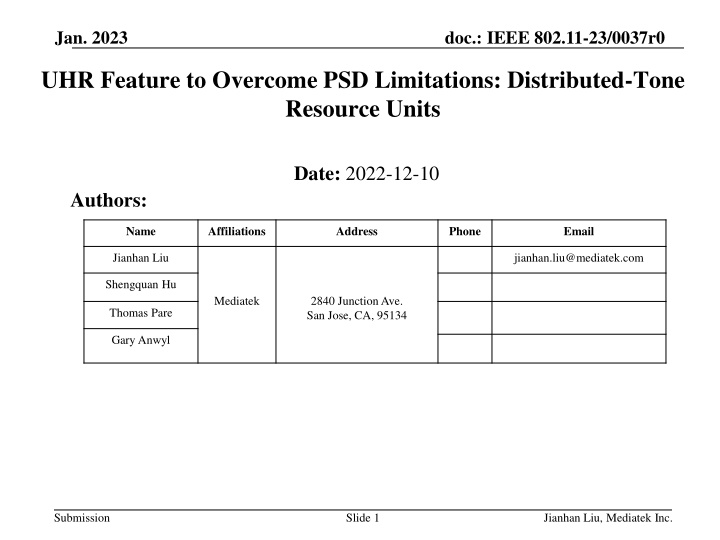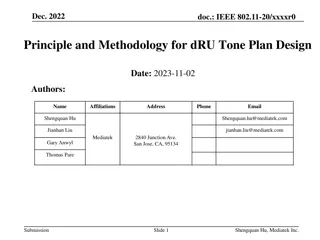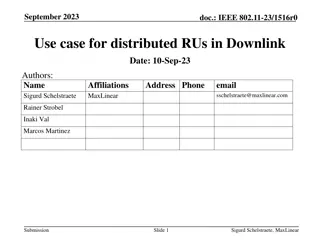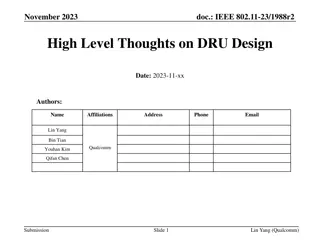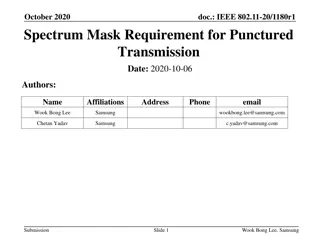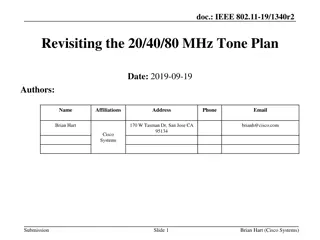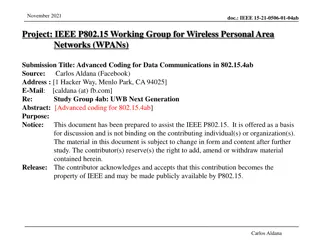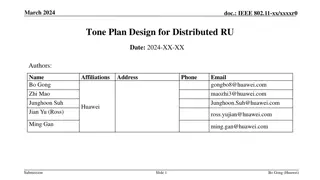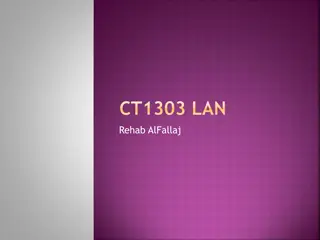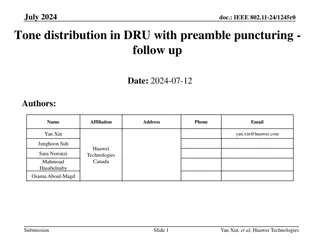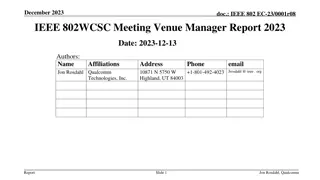Enhancing Wireless Spectrum Efficiency with Distributed-Tone Resource Units in IEEE 802.11
In the document "Jan 2023.doc: IEEE 802.11-23/0037r0," the focus is on leveraging Distributed-Tone Resource Units (dRU) to overcome Power Spectral Density (PSD) limitations in wireless communication. By distributing tones over a wide bandwidth, dRU allows for higher transmit power, enabling enhanced spectrum efficiency and extended range. The concept is particularly useful in UL-OFDMA scenarios, showcasing how dRU can optimize power distribution among multiple stations. This approach offers a significant boost in transmit power compared to traditional Resource Units (rRU), fostering improved performance and increased flexibility in wireless networking.
Download Presentation

Please find below an Image/Link to download the presentation.
The content on the website is provided AS IS for your information and personal use only. It may not be sold, licensed, or shared on other websites without obtaining consent from the author.If you encounter any issues during the download, it is possible that the publisher has removed the file from their server.
You are allowed to download the files provided on this website for personal or commercial use, subject to the condition that they are used lawfully. All files are the property of their respective owners.
The content on the website is provided AS IS for your information and personal use only. It may not be sold, licensed, or shared on other websites without obtaining consent from the author.
E N D
Presentation Transcript
Jan. 2023 doc.: IEEE 802.11-23/0037r0 UHR Feature to Overcome PSD Limitations: Distributed-Tone Resource Units Date: 2022-12-10 Authors: Name Affiliations Address Phone Email Jianhan Liu jianhan.liu@mediatek.com Shengquan Hu Mediatek 2840 Junction Ave. San Jose, CA, 95134 Thomas Pare Gary Anwyl Submission Slide 1 Jianhan Liu, Mediatek Inc.
Jan. 2023 doc.: IEEE 802.11-23/0037r0 Regulations Put Limitations on Power Spectral Density (PSD) in Sub-7GHz In 6GHz bands, PSD limitations are tougher. For a non-AP STA in LPI bands, the PSD limitation is -1dBm/MHz. For a 52-tone RU, the maximum TX power now is only about 6dBm. In different regions, regulations also put different limitations on 2.4GHz and 5GHz bands. For example, 10dBm/MHz PSD limitations are put on 2.4GHz bands in EU/China/ Japan/Korea. Note that for a 52-tone RU, the maximum TX power is about 17dBm. Even in 5GHz bands, we can boost transmit power if we can walk around the PSD limitations. For a 52-tone RU, the maximum TX power now is about 24dBm which is still 6dB away from the maximum allowed EIRP 30dBm. If we can overcome the PSD limitations, we can enhance the transmit power and therefore enhance the spectrum efficiency or extend the range. Submission Slide 2 Jianhan Liu, Mediatek Inc.
Jan. 2023 doc.: IEEE 802.11-23/0037r0 Regulations on Power Spectral Density (PSD) in Sub-7GHz 5 GHz Power Spectral Density 5.15 - 5.25 GHz 5.25 - 5.35 GHz 5.47 - 5.65 GHz 5.65 - 5.725 GHz 5.725 - 5.85 GHz Country / Geo Unit dBm / MHz dBm / MHz Conductor 11 (17 AP) 11 11 11 33 EIRP 17 (24 AP) 17 17 17 39 Tx Power Limit Conductor 24 24 24 24 30 dBm EIRP 30 30 30 30 36 dBm Submission Slide 3 Jianhan Liu, Mediatek Inc.
Jan. 2023 doc.: IEEE 802.11-23/0037r0 Distributed-Tone Resource Units (dRU) Come to Rescue Note that the PSD limitations are defined by per MHz and for each STA. If we distribute tones of a small-size RU over a wide bandwidth, then the tones for each STA become non-contiguous and therefore each tone can be transmitted with higher power. For convenience, we call the RUs defined in 11ax and 11be with contiguous tones as regular RUs (rRU) and call the RUs with distributed tones as distributed tones RU (dRU). For a STA transmits dRU, it can transmit much higher power compared to rRU. For example, for a 52-tone dRU over 80MHz, there can be just one tone per MHz. But for a 52-tone rRU, there are about 13 tones per MHz. With PSD limitations as -1dBm/MHz in 6GHz LPI bands, for 52-tone RU, using dRU can boost transmit power by 11dB! This significant transmit power boost can enable higher MCSs or reach longer range. Submission Slide 4 Jianhan Liu, Mediatek Inc.
Jan. 2023 doc.: IEEE 802.11-23/0037r0 Distributed-Tone Resource Units (dRU) in UL-OFDMA dRU is particularly useful in UL-OFDMA. As shown in the following figure, STA1, STA2 and STA3 can all boost its transmit power by using dRU. Compared to using same size rRU, all the tones get higher transmit power and therefore overall spectrum efficiency is enhanced significantly. STA2 on dRU2 STA3 on dRU3 (dRU2 is composed of Green Colored Tones) (dRU3 is composed of Blue Colored Tones) STA1 on dRU1 (dRU1 is composed of Red Colored Tones) AP Submission Slide 5 Jianhan Liu, Mediatek Inc.
Jan. 2023 doc.: IEEE 802.11-23/0037r0 Power Boost of dRUs To maximize the power boost, the tones in one dRU should be spread out as large as possible (the optimal solution is 1 tone/MHz). dRU size should be kept same as rRU size to avoid extra complexity. The following table shows the achievable power boost for different dRUs distributed on different bandwidths. We use 6GHz LPI as an example. We can also get power boost in 2.4GHz and 5GHz in different regions. dRU Power Boost Compared to rRU in 6GHz LPI bands BW20 BW40 BW80 Power Boost (dB) Power Boost (dB) Power Boost (dB) RU26 RU52 RU106 RU242 RU484 8.13 6.37 3.56 na na 11.14 8.13 6.37 2.69 na 11.14 11.14 8.13 5.12 2.69 Submission Slide 6 Jianhan Liu, Mediatek Inc.
Jan. 2023 doc.: IEEE 802.11-23/0037r0 Power Boost of dRUs (cont s) We can see that dRU can overcome the PSD limitations and bring significant gain. For example, for an 80MHz UL-OFDMA transmission with 8 users, each user using 106-tone dRUs, compared each user using 106-tone rRU, the overall performance can be improved by 8.13dB. Submission Slide 7 Jianhan Liu, Mediatek Inc.
Jan. 2023 doc.: IEEE 802.11-23/0037r0 Summary We pointed out the regulated PSD limitations in sub-7GHz and those PSD limitations reduce the transmit power. We introduced the concept and idea of Distributed-Tone Resource Units (dRU) to overcome the regulated PSD limitations. We showed the dRU can significantly boost transmit power in UL- OFDMA. Submission Slide 8 Jianhan Liu, Mediatek Inc.
Jan. 2023 doc.: IEEE 802.11-23/0037r0 Straw Poll #1 Do you agree that Distributed-Tone Resource Units (dRU) should be considered as a feature for the UHR? Submission Slide 9 Jianhan Liu, Mediatek Inc.
